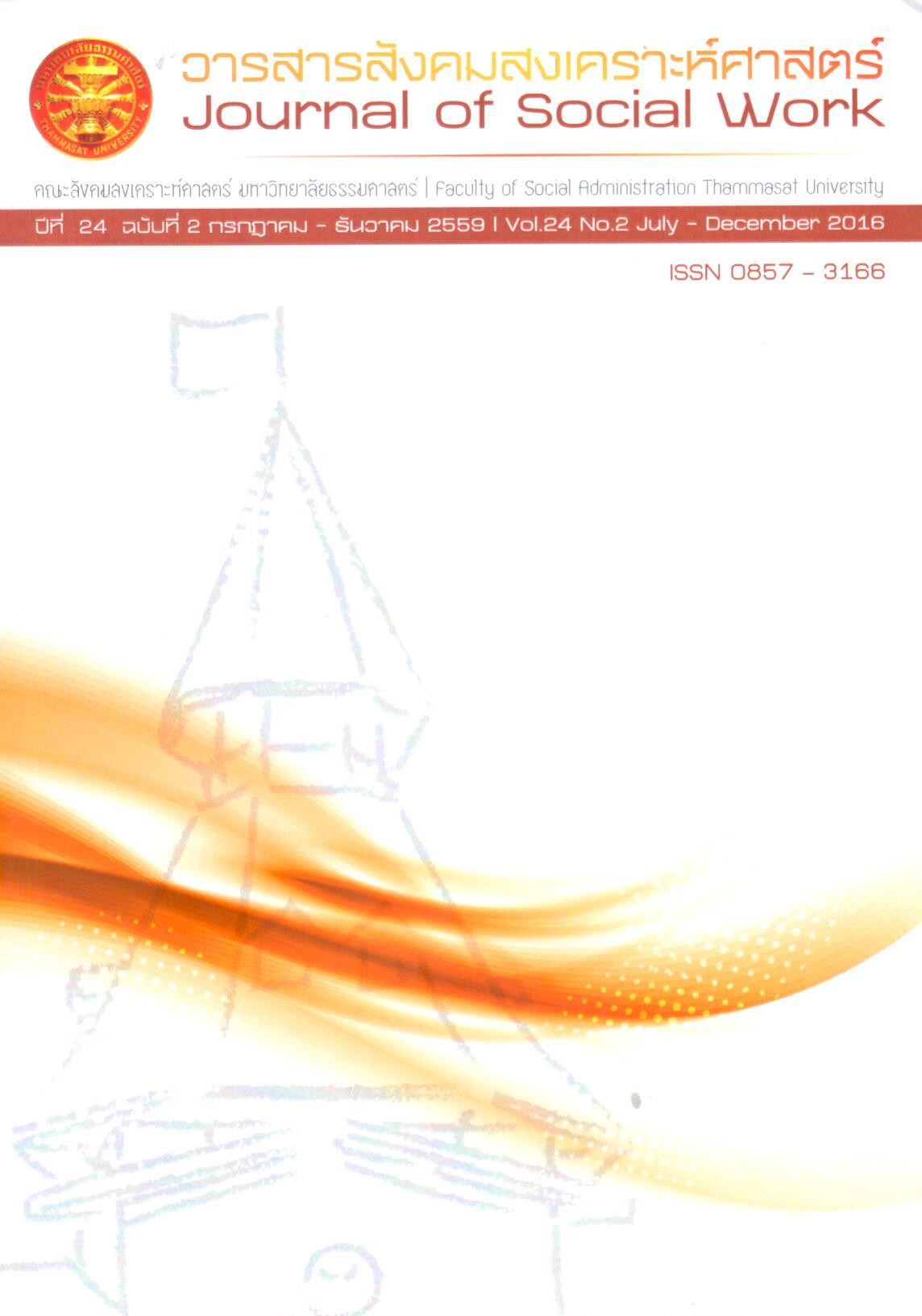แนวทางการพัฒนากฎหมายเพื่อคุ้มครองสิทธิและสงเคราะห์ผู้พ้นโทษในประเทศไทย
คำสำคัญ:
กฎหมายสวัสดิการสังคม, คุ้มครองสิทธิ, สงเคราะห์, ผู้พ้นโทษบทคัดย่อ
บทความวิจัย เรื่อง “แนวทางการพัฒนากฎหมายเพื่อคุ้มครองสิทธิและสงเคราะห์ผู้พ้นโทษในประเทศไทย” มีวัตถุประสงค์ เพื่อศึกษา ค้นคว้า แนวคิดด้านสิทธิและการคุ้มครองสิทธิ การลงโทษ การสงเคราะห์ผู้กระทำผิดและทฤษฎีทางสวัสดิการสังคม เพื่อศึกษาพัฒนาการของกฎหมายในการที่เกี่ยวข้องกับผู้พ้นโทษในประเทศไทยและต่างประเทศ เพื่อศึกษาวิเคราะห์เชิงลึกในประเด็นช่องว่างและข้อจำกัดของกฎหมายสำหรับการสงเคราะห์ผู้พ้นโทษของประเทศไทยเปรียบเทียบกับต่างประเทศ และสุดท้าย เพื่อหาแนวทางในการพัฒนากฎหมายด้านสวัสดิการสังคมสำหรับการสงเคราะห์ผู้พ้นโทษ วิธีการศึกษาเป็นการวิจัยเชิงคุณภาพ (Qualitative Research) โดยการศึกษาเปรียบเทียบกฎหมาย (Comparative Law) มีขอบเขตในการศึกษาวิเคราะห์กฎหมายด้านการคุ้มครองสิทธิและสงเคราะห์ผู้พ้นโทษ และกฎหมายที่เกี่ยวข้องทั้งในประเทศและต่างประเทศ ประโยชน์ที่คาดว่าจะได้รับ ได้แก่ ทำให้ได้ประเด็นสำคัญเชิงลึกและเชิงเปรียบเทียบทางกฎหมายในการคุ้มครองสิทธิและสงเคราะห์ผู้พ้นโทษ อีกทั้งจะได้ข้อเสนอแนะในการพัฒนาร่างกฎหมายเพื่อการคุ้มครองสิทธิและสงเคราะห์ผู้พ้นโทษที่มีประสิทธิภาพ ที่เป็นธรรม
ผลการศึกษาจากข้อมูลทางวิชาการ สามารถตอบวัตถุประสงค์ที่ตั้งไว้ โดยพบว่า การคุ้มครองสิทธิขั้นพื้นฐานของประชาชนจะต้องเป็นไปตามหลักปฏิญญาสากลว่าด้วยสิทธิมนุษยชน และกติการะหว่างประเทศว่าด้วยสิทธิพลเมืองและสิทธิทางการเมือง สำหรับประเทศไทยเมื่อปี พ.ศ.2497 เคยมีประกาศใช้ “พระราชบัญญัติสงเคราะห์บุคคลผู้ที่ได้รับการพักการลงโทษ ผู้พ้นโทษ และเด็กผู้พ้นการฝึกอบรม พ.ศ.2497” แต่มิได้มีการดำเนินในเชิงคุ้มครองสิทธิและสงเคราะห์อย่างจริงจังแต่อย่างใด และได้มีการยกเลิกไปเมื่อ พ.ศ.2499 ทำให้ประเทศไทยไม่มีกฎหมายคุ้มครองสิทธิและสงเคราะห์ผู้พ้นโทษโดยเฉพาะที่เป็นกิจจะลักษณะ จึงควรมีการบัญญัติกฎหมายเฉพาะในการคุ้มครองสิทธิและสงเคราะห์ผู้พ้นโทษ เพื่อป้องกันมิให้บุคคลเหล่านั้นหวนกลับไปกระทำความผิดอีก จึงควรมีการกระจายความเป็นธรรมทางสังคมไปยังกลุ่มที่มีความเปราะบางทางสังคมกลุ่มนี้ ในการศึกษาจึงมีข้อเสนอให้พัฒนาร่างบทบัญญัติทางกฎหมาย เพื่อให้ผู้พ้นโทษควรได้สิทธิบางอย่างกลับคืนดังเช่นในต่างประเทศ เช่น การสามารถเข้ารับราชการในตำแหน่งที่ไม่เกี่ยวข้องกับการกระทำผิดที่ผ่านมา ในส่วนของความผิดที่ไม่ร้ายแรง รัฐอาจดำเนินการลบประวัติอาชญากรให้ได้ หากบุคคลนั้นมิได้กระทำผิดซ้ำในระยะเวลาที่กำหนด (Period of rehabilitation) นอกจากนี้ กฎหมายควรมีการกำหนดขอบเขตอำนาจหน้าที่หน่วยงานที่ดำเนินงานสงเคราะห์ผู้พ้นโทษให้ชัดเจน รวมทั้ง ควรกำหนดอำนาจหน้าที่ตามกฎหมายของอาสาสมัครคุมประพฤติหรืออาสาสมัครที่เกี่ยวข้องในพื้นที่เพื่อช่วยเหลือผู้พ้นโทษและเป็นการเฝ้าระวังเชิงป้องกันอาชญากรรมไปในตัวด้วย
เอกสารอ้างอิง
กิติพัฒน์ นนทปัทมะดุลย์. (2554). นโยบายสังคมและสวัสดิการสังคม, กรุงเทพฯ: สำนักพิมพ์มหาวิทยาลัยธรรมศาสตร์.
กิตติพงษ์ กิตยารักษ์. ยุทธศาสตร์การพัฒนากระบวนการยุติธรรมเพื่อคนจน, 2548. [สืบค้นเมื่อวันที่ 20 ตุลาคม 2559] จาก http://www.geocities.com/ rightfreedom /academic/08.html
โกวิทย์ พวงงาม. (2550). การปกครองท้องถิ่นไทย: หลักการและมิติใหม่ในอนาคต. กรุงเทพฯ สำนักพิมพ์วิญญูชน.
สำนักงานส่งเสริมสวัสดิภาพและพิทักษ์เด็ก เยาวชน ผู้ด้อยโอกาส คนพิการและผู้สูงอายุ (สท.) กระทรวงการพัฒนาสังคมและความมั่นคงของมนุษย์ รูปแบบการกระบวนการคุ้มครองและพิทักษ์สิทธิผู้ด้อยโอกาส กลุ่มผู้พ้นโทษ, 2551.
สำนักงานส่งเสริมสวัสดิภาพและพิทักษ์เด็ก เยาวชน ผู้ด้อยโอกาส คนพิการและผู้สูงอายุ (สท.) กระทรวงการพัฒนาสังคมและความมั่นคงของมนุษย์ การศึกษาวิจัยและพัฒนารูปแบบแนวทางในการนำกระบวนการคุ้มครองและพิทักษ์สิทธิ ผู้ด้อยโอกาส กลุ่มผู้พ้นโทษไปสู่การปฏิบัติ 2553.
นงลักษณ์ เทพสวัสดิ์. (2540). ทฤษฎีและการปฏิบัติงานสังคมสงเคราะห์. กรุงเทพฯ: สำนักพิมพ์มหาวิทยาลัยธรรมศาสตร์.
บรรเจิด สิงคะเนติ. (2554). หลักพื้นฐานเกี่ยวกับสิทธิเสรีภาพและศักดิ์ศรีความเป็นมนุษย์. พิมพ์ครั้งที่ 3, กรุงเทพฯ: โรงพิมพ์เดือนตุลา.
ทิพาภรณ์ โพธิ์ถวิลและระพีพรรณ คำหอม. องค์ความรู้เกี่ยวกับการพัฒนาคุ้มครองและพิทักษ์สิทธิผู้ด้อยโอกาส รายงานการวิจัย เสนอต่อ สำนักส่งเสริมและพิทักษ์ผู้ด้อยโอกาส สำนักงานส่งเสริมสวัสดิภาพและพิทักษ์เด็ก เยาวชน ผู้ด้อยโอกาส คนพิการ และผู้สูงอายุ 2549.
ธวัชชัย ไทยเขียว. (รองปลัดกระทรวงยุติธรรม) ข่าว Nation TV, 21 พฤษภาคม 2558 [สืบค้นเมื่อวันที่ 20 กรกฎาคม 2559] http://www.nationtv.tv/main/ content/politics/378456647/
นัทธี จิตสว่าง. (2541). หลักทัณฑวิทยา. กรุงเทพฯ: ม.ป.ท..
ยุพา วงศ์ไชย. นโยบายสวัสดิการสังคม. คณะสังคมสงเคราะห์ศาสตร์ มหาวิทยาลัย ธรรมศาสตร์, 2545.
วันทนีย์ วาสิกะสิน และคณะ. (2547). ความรู้ทั่วไปเกี่ยวกับสวัสดิการสังคมและสังคมสงเคราะห์. มหาวิทยาลัยธรรมศาสตร์.
วิทยา สุริยะวงศ์. (อดีตอธิบดีกรมราชทัณฑ์) ข่าวมติชนออน์ไลน์ [สืบค้นเมื่อวันที่ 20 กรกฎาคม 2559] http://www.matichon.co.th/news/5221
ศุภชัย เยาวะประภาษ. นโยบายสาธารณะ. พิมพ์ครั้งที่ 3 กรุงเทพฯ: สำนักพิมพ์แห่งจุฬาลงกรณ์ มหาวิทยาลัยธรรมศาสตร์, 2540.
สัญญา สัญญาวิวัฒน์. ทฤษฎีและกลยุทธ์การพัฒนาสังคม. กรุงเทพมหานคร: สำนักพิมพ์แห่งจุฬาลงกรณมหาวิทยาลัย, 2540.
สุรเกียรติ เสถียรไทย. กฎหมายกับชุมชน-มิติใหม่ของการพัฒนา. กรุงเทพมหานคร: สำนักพิมพ์ร่วมด้วยช่วยกัน, 2542.
สมโภชน์ เอี่ยมสุภาษิต. ทฤษฎีและเทคนิคการปรับพฤติกรรม. กรุงเทพฯ: สำนักพิมพ์จุฬาลงกรณ์มหาวิทยาลัย, 2536.
อภิญญา เวชยชัย และกิตติพัฒน์ นนทปัทมะดุลย์. การพัฒนาระบบสวัสดิการสำหรับคนจนและคนด้อยโอกาส : กลุ่มคนจนผู้ด้อยโอกาสและกลุ่มเสี่ยงที่ประสบปัญหาทางสังคม. กรุงเทพมหานคร ศูนย์ศึกษาเศรษฐศาสตร์การเมือง จุฬาลงกรณ์มหาวิทยาลัย, 2546.
Bartollas, C. (1985). Correctional Treatment: Theory and Practice. New Jersey: Prentice-Hall, Inc.
Cameron, B. Federal Prison Consultant Explains the Second Chance Act. December 30, 2014 Retrieved Aug. 15, 2016, from http://www.federal prisonauthority.com/second-chance-act/
Callison, H. G. (1983). Introduction to Community-based Corrections. New York : McGraw- Hill Book Company.
Council of State Government, Second Chance Act of 2007. Justice Center, Retrieved June 10, 2016, from https://apa.org/about/gr/science/ advocacy/2008/second-chance-act-2007.pdf
Farkac, A. J. (2014). The Media’s Presentation of The Second Chance Act: Funding for Reentry Following Prison. Portland State University.
Hirsch, A. V. (1976). Doing Justice: The Chioce of Punishment. New York: Hill and Wang.
Hughes, G. and Edwards, A. (2002). Crime Control and Community: the New Politics of Public Safety. U.S.A.: Willan Publishing.
James, N. (2015).Offender Reentry: Correctional Statistics, Reintegration into the Community, and Recidivism Analyst in Crime Policy, January 12.
Kidder, R. L. (1983). Connecting Law and Society: An Introduction to Research and Theory. New Jersey: Prentice Hall, Inc.
Local Government Association. The Care Act and Prisoners – Implications for Local Authorities. Retrieved June 22, 2016, from http://www.local.gov. uk/documents/10180/5756320/Care+Act+and +Prisons+-+Briefing +note/2aaf1e35-b1f8-41a5-999c-d98905dea85f
Kane, L. (2010). A Project of CSG Justice Center. National Reentry Resource Center, Retrieved July 8, 2016, from http://cebcp.org/wp-content/CB 2010/Kane
Neil, G. and Terrell, P. (1998). Dimension of Social Welfare Policy. U.S.A.: Allyn and Bacon.
Parliament, United Kingdom. The retention and disclosure of criminal records. Published Wednesday, August 12, 2015. Retrieved July 5, 2016, from (http://researchbriefings.parliament.uk/ResearchBriefing /Summary/SN06441)
Robinson, G. and Crow, I. D. (2009). Offender Rehabilitation: Theory, Research and Practice, London: SAGE Publications.
Reid, S. T. (1981). The Correctional System: An Introduction. Cengage Learning.
Sykes, G. M. and Cullen F. T. (1992). Criminology. 2nd ed. Florida : Harcourt Brace Jovanovich, Inc.
University of Alabama, School of Law. Cross-Disciplinary Legal Studies., Retrieved June 21, 2014, from http://www.law.ua.edu/academics/ cross-disciplinary-legal-studies-program/
U.S. Department of Education. Education Department Pushes for Alternatives to Criminal History Questions in College Admissions. May 9, 2016. Retrieved June 29, 2016, from https://www.ed.gov/news/press-releases/education-department-pushes-alternatives-criminal-history-questions-college-admissions
Williams, Lucy A. Welfare Law. Berlington, U.S.A: Ashgate Publishing Company, 2001.
Winstone, Jane. (2016). Mental Health, Crime and Criminal Justice: Responses and Reforms. UK: Palgrave Macmillan.
Offenders Rehabilitation Act 2007 (Japan)
Rehabilitation of Offenders Act 1974 (United Kingdom)
Second Chance Act 2007 (United States of America)
ดาวน์โหลด
เผยแพร่แล้ว
รูปแบบการอ้างอิง
ฉบับ
ประเภทบทความ
สัญญาอนุญาต
ผลงานที่ตีพิมพ์ในวารสารสังคมสงเคราะห์ศาสตร์เป็นลิขสิทธิ์ของวารสารสังคมสงเคราะห์ศาสตร์ มหาวิทยาลัยธรรมศาสตร์ และวารสารสังคมสงเคราะห์ศาสตร์ มหาวิทยาลัยธรรมศาสตร์ ขอสงวนสิทธิในการเผยแพร่ผลงานที่ตีพิมพ์ในแบบรูปเล่มและทางสื่ออิเล็กทรอนิกส์อื่นใด
บทความหรือข้อความคิดเห็นใดๆ ที่ปรากฏในวารสารสังคมสงเคราะห์ศาสตร์เป็นความรับผิดชอบของผู้เขียนโดยเฉพาะ คณะสังคมสงเคราะห์ศาสตร์ มหาวิทยาลัยธรรมศาสตร์ และบรรณาธิการไม่จําเป็นต้องเห็นด้วยหรือร่วมรับผิดชอบใดๆ



